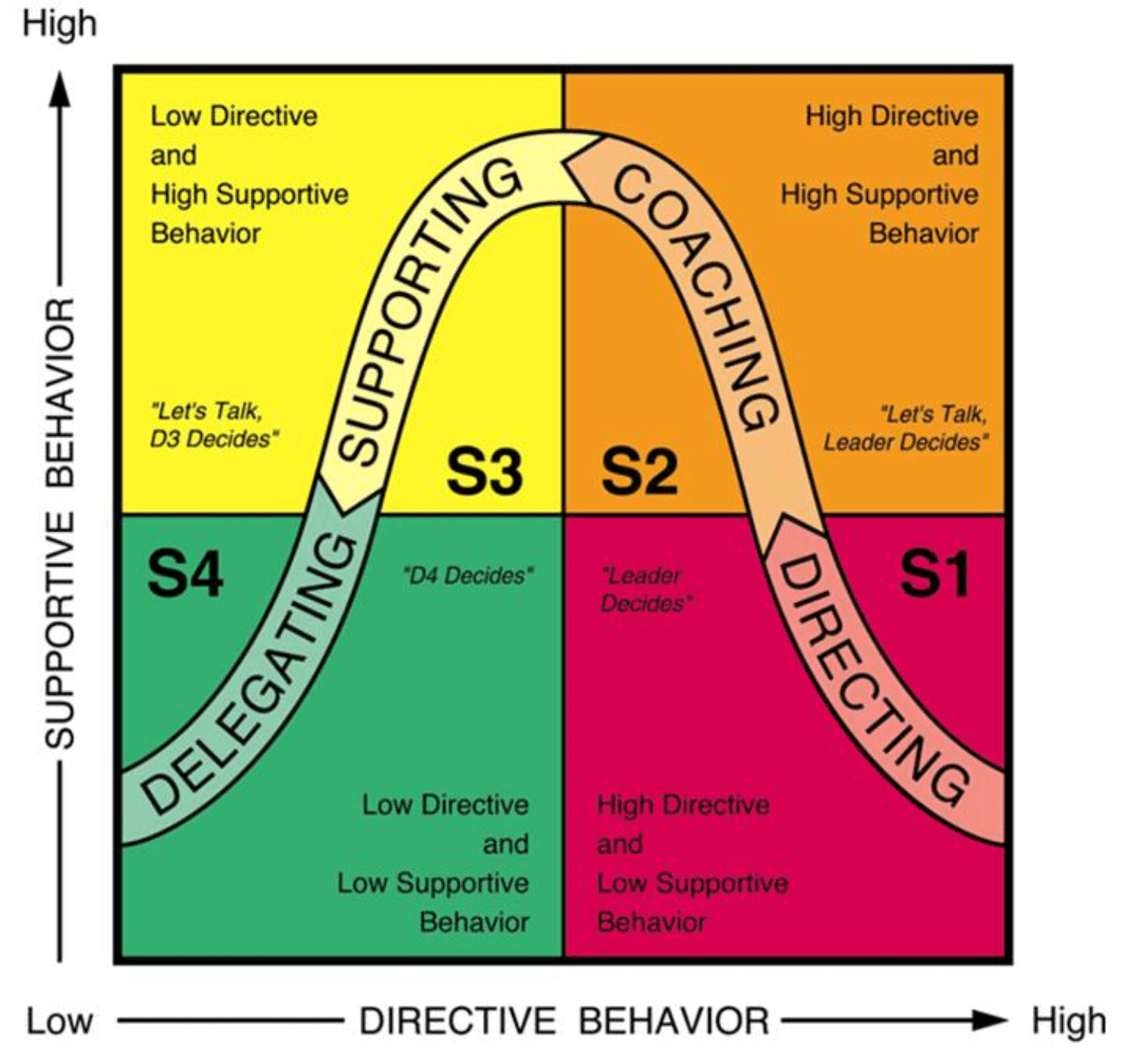Have you ever watched coaches in professional soccer? It appears they’re just another spectator. They rarely get out of their sideline seat, perhaps only to celebrate a goal in a close game. If they say anything all game, it’s to call one or two substitutions. Otherwise, they’re stoic. Oh, sure, they picked the starting line-up. But what is it that they do that we’d call them “Coach”? Pro soccer starkly contrasts American football, where the line-up changes with every snap, and a small platoon of coaches call every play. Have you ever watched a football coach sit during the game, let alone the entire game? These general coaching styles illustrate situational leadership. Their style is adapted to their respective game situations.
Leadership that gets results calls on a repertoire of leadership styles. If you or your noncoms have only one style in which you operate, your mission is suffering and you’re not developing your guys. This is particularly the case in Battalion where developing your guys is the mission.
I’ve found Paul Hersey and Ken Blanchard’s “Situational Leadership” model to work well both with training teen leaders in Battalion, and the midshipmen I’m preparing for naval commissions. The model emerged in the 1970s from their scholarly Management of Organizational Behavior, and was then popularized in Blanchard’s One Minute Manager series. My Battalion guys understand it quickly, providing us a vocabulary to talk about scenes from our battalion, whether how I chose to lead them in a situation, or evaluating whether they chose the right style for a situation in which they found themselves.
My reply was consistently, “Confer with your noncoms. You decide and tell me what you want to do. The ministry is yours. Not mine.”
A web search of “Situational Leadership” will uncover several dozen variations of the following graphic. This one’s from a Blanchard associate’s website.

The blocks to the right depict styles where the leader directly engages with in the desired team behavior; he’s invested in the task. Whereas, the left depicts leaders more detached from the mission task. Blocks on the top depict styles where the leader invests in the people. Whereas the people aren’t primary in the lower two blocks. The resulting quadrants depict applicable styles “S1: Directing”, “S2: Coaching”, “S3: Supporting”, “S4: Delegating.”
http://learningpointinc.com/wp-content/uploads/2015/01/situational-leadership-model.jpg
What do these look like in a Battalion setting? In Directing (S1), I’m giving explicit directions for how things are to be done. The boys are pretty much doing what they’re told. My language is directive, in the imperative tense. “Make camp here.” “Brent, go get fire wood.” I might ask a question, but it’s followed by an order.
In Coaching (S2), questions appear more frequently. Making camp after hiking through rain all day, I might notice the noncoms setting up their tents. I’d ask the Master Sergeant, “Sam, did everyone’s sleeping bag stay dry?” “I’ll ask them.” “Shouldn’t someone else be asking that question?” “Oh, right. I’ll have the squad leaders check.” Here, I’m having to coach Sam into patterns, getting him to think like I think. But, it takes some nudging. Because I’m dealing with Sam in S2, he’s probably dealing with his squad leaders in S1. That’s OK, until they learn that Sam will always be asking for a health and welfare check, soon after making camp.
In Supporting (S3), I’ve detached myself from particulars, allowing Sam and his leadership team to own more. With some additional trips, Sam will start to expect my question, “How are we doing?” Now my question is vague, but he now knows what I mean. “Mark has a blister, which Nate treated. Everyone’s tent is pitched. All John’s clothes are soaked, but Ben’s got him in the noncoms’ spares. We’ll start dinner soon. When shall we do Counsel Ring?” With this question, Sam’s asking me back into Coaching. I resist. “It’s your ministry; not mine. Poll your noncoms, and let the adults know what you decide.” My focus is on Sam’s ownership of what gets done, not the tasks themselves.
In Delegating (S4), I’m matching a person to a responsibility, and expecting they’ll do all the requisite tasks, without my interference. A mature junior typically gets “Admin Sergeant” for a semester, which means gathering registrations, monies, permission slips for 40-50 guys and dads. They’ll email a tentative roster on Wednesday, and Friday will show up with a smooth roster with emergency contact info, and an accounting of all funds, with the cash and checks separated. The prior semester’s Admin showed them the ropes. My role is simply to say, “Thank you. Tell me when you’ve got everyone.” I’m not investing in either the task or the Admin Sergeant. He neither wants nor needs my help. The similar is true for the quartermaster, who ensures the needed gear is pulled from storage for a particular trip. I’m not going to check his work; we’ll find out soon enough if he forgot something important.
I’ve learned that most men expect this Navy Captain to pretty much campout in S1, whether at work or afield with Battalion. After all, isn’t that what military leadership is all about? Giving order and expecting a cheery “Aye, aye, sir!” Maybe in movies. I want to spend most of my time in Supporting and Delegating. Face it. If I can’t get my people to the point to where I can move to Delegating, I can’t sleep. My Skippers lived in Supporting and Delegating when I was a LT, as soon as my maturing competence convinced them they could take a step back.
How do you know which style to employ? It depends on the situation, and particularly the competence of those you’re leading, and the clarity with which you’ve communicated the mission. That’s why you see a flow depicted. As they grow in competence, from novice to expert, in the mission you’ve defined, you can and should allow them to own more of the responsibility, including the decisions. Note the quotes in each box below, suggesting more and more decision-making authority ceded to those you lead. The D3 and D4 refer to another facet of the model. You’re not developing leaders unless you yourself are operating in Supporting and Delegating.
Do I shift to Directing on occasion? Absolutely, in a flash, if there’s a significant threat to life or limb. But these are very rare, and I’d prefer to quietly prod the Master Sergeant vice speak to a younger boy directly. I will though, if protecting sheep demands it, after which my sons would report to their mother, “Sammy got to meet the Captain this weekend,” by which they meant Sammy learned I have a different voice I reserve for S1. It was notable, because it was rare.
When I took over as our Battalion’s Captain, years ago, the Master Sergeant routinely approached me with “Sir, should we do X, or Y?” My reply was consistently, “Confer with your noncoms. You decide and tell me what you want to do. The ministry is yours. Not mine.” After the first year, I didn’t have to say this as often. Guys owned the work, and rising noncoms looked forward to taking charge.
Your noncoms can handle this, and it will provide a helpful model for talking about their leadership. Set apart an hour for a noncom meeting. Either project or draw the grid above on a chalk board. Tell them stories they might recall of you dealing with them in each quadrant, and what situations match the quadrants. Then break them into four groups and give them 5 minutes to prepare two 1-2 minutes skit illustrating the appropriate and inappropriate use of the quadrant they were assigned. Have them do their skits for one another. Those with camp staff experience will have the richest story base from which to draw. They’ll get it.
Each of the above leadership patterns are seen in Scripture. I’ll leave finding them to reader as homework. This too is a great exercise for your noncoms.
For more reading:
– NOLS Leadership Educators Notebook. https://store.nols.edu/collections/publications/products/wilderness-educator-notebook Every Battalion Captain should have this.
– Ken Blanchard,
– Leadership and the One Minute Manager.
- Lead Like Jesus
- Servant Leader
– My classmate, Captain David Marquet’s book Turn the Ship Around, instantiates this approach to leadership. The following video humorously conveys David’s message: https://www.youtube.com/watch?v=OqmdLcyES_Q
Captain Rob Niewoehner, US Navy(ret), PhD, serves as the Brigade Chairman and Elder at Annapolis Evangelical Presbyterian Church, Maryland. An experimental test pilot, he teaches Aerospace Engineering and Engineering Leadership at the United States Naval Academy.



